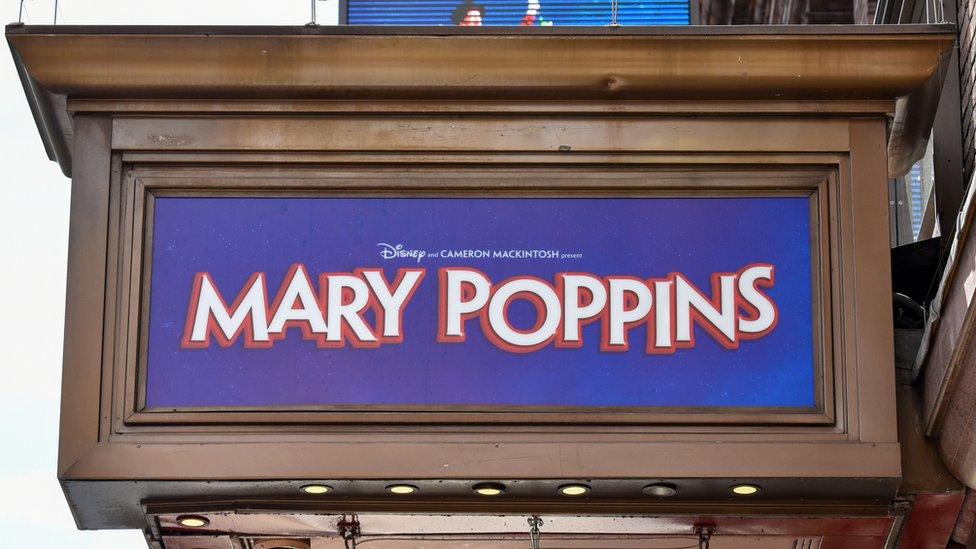Coronavirus: What is happening to live music and theatre?
- Published
- comments

Whether it is Shakespeare or Sheeran, Matilda or Mary Poppins, West End productions, pantos and music concerts play a big part in bringing excitement to our lives.
But theatres and concert halls have been told they must remain shut for live performances because of coronavirus - and many say they are facing ruin as a result.
The government has now issued a five-step plan to help the arts venues survive.
Culture Secretary Oliver Dowden said he wanted "to raise the curtain on live performances" as soon as possible.
But he has not said if there will be any extra money to help them, which a lot of the venues have said they need.
What is the arts industry?
The Lion King was due to start its run in Cardiff next month - it will now be on hold until 2022
Maybe you have seen The Lion King on stage, visited the Natural History Museum to marvel at the massive whale skeleton, or perhaps you caught last year's biggest movie, Avengers: Endgame at the cinema?
Places like these are all part of the arts sector. It is made up of theatres, cinemas, museums, music halls and art galleries.
They are an important part of the UK, not only for the enjoyment they bring, but because they make billions of pounds for the UK each year and employ thousands of people.
Why can't all of the arts industry reopen?
Prime Minister Boris Johnson announced that some areas of the arts sector can reopen in July
All parts of the arts industry were forced to close in March, at the start of the coronavirus lockdown.
Prime Minister Boris Johnson has said that from 4 July, cinemas, galleries and museums could reopen, as long as they are made safe for the public.
From that date, social distancing rules on how much space people should leave between themselves and others is also going to change, from two metres to one-metre-plus.
But while theatre and music hall buildings are allowed to be used, performances in them will not be allowed, because some scientists and government ministers believe that singing and dancing could spread coronavirus, especially for those sitting close to the stage.
There are also concerns that the rules around social distancing will make filling theatres impossible. Even if performances are allowed to take place, empty seats and less tickets sold will mean theatres do not make enough money for shows to run.
Will theatres and venues have to shut for good?
Les Mis茅rables will not reopen until 2021
Lockdown has had a big impact on the arts industry.
Research by the Society of London Theatre and UK Theatre suggests that 70% of theatres will run out of money by the end of the year.
And, without government support, 400,000 jobs could be lost, according to one study.
Celebrities, entertainers and also Prince Charles, have been speaking up about the challenges the arts world is facing and calling on the government to help.
Last week, almost 100 leading performers, writers and directors joined together to send a letter to the government warning that "British theatre was on the brink of ruin".
They added that lots of theatres could completely run out of money and never be able to reopen, even after they are allowed to.
Sir Cameron Mackintosh, the producer of hit West End shows including Les Mis茅rables, Mary Poppins and The Phantom of the Opera, has said they will not return until 2021.
What is being done about it?
The government has come up with its five-stage plan as a way for theatres and other venues to survive the lack of customers during lockdown.
Culture Secretary Mr Dowden said: "Theatres must be full to make money, and performers need to be safe on stage as they sing, dance and play instruments.
"But I am determined to ensure the performing arts do not stay closed longer than is absolutely necessary to protect public health."
The first two stages of the plan can be started immediately, the government has said.
The five stages are:
Stage One - Rehearsal and training (no audiences and following social distancing guidelines)
Stage Two - Performances for broadcast and recording purposes (following social distancing guidelines)
Stage Three - Performances outdoors with an audience plus trials of indoor performances with a limited, socially- distanced audience
Stage Four - Performances allowed indoors/outdoors (but with a limited distanced audience indoors)
Stage Five - Performances allowed indoors/outdoors (with a fuller audience indoors).
Are you looking forward to being able to go and see shows again? Which show would you really want to watch? Let us know in the comments below.
- Published23 June 2020
- Published24 June 2020
